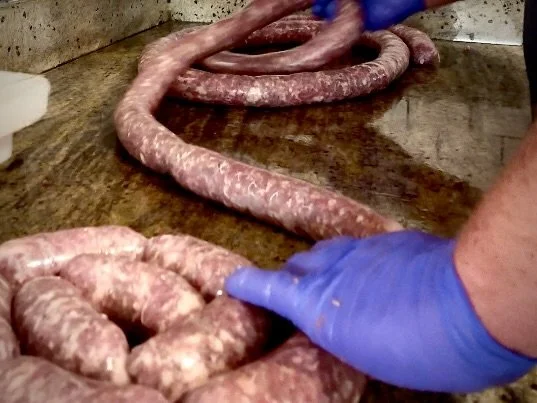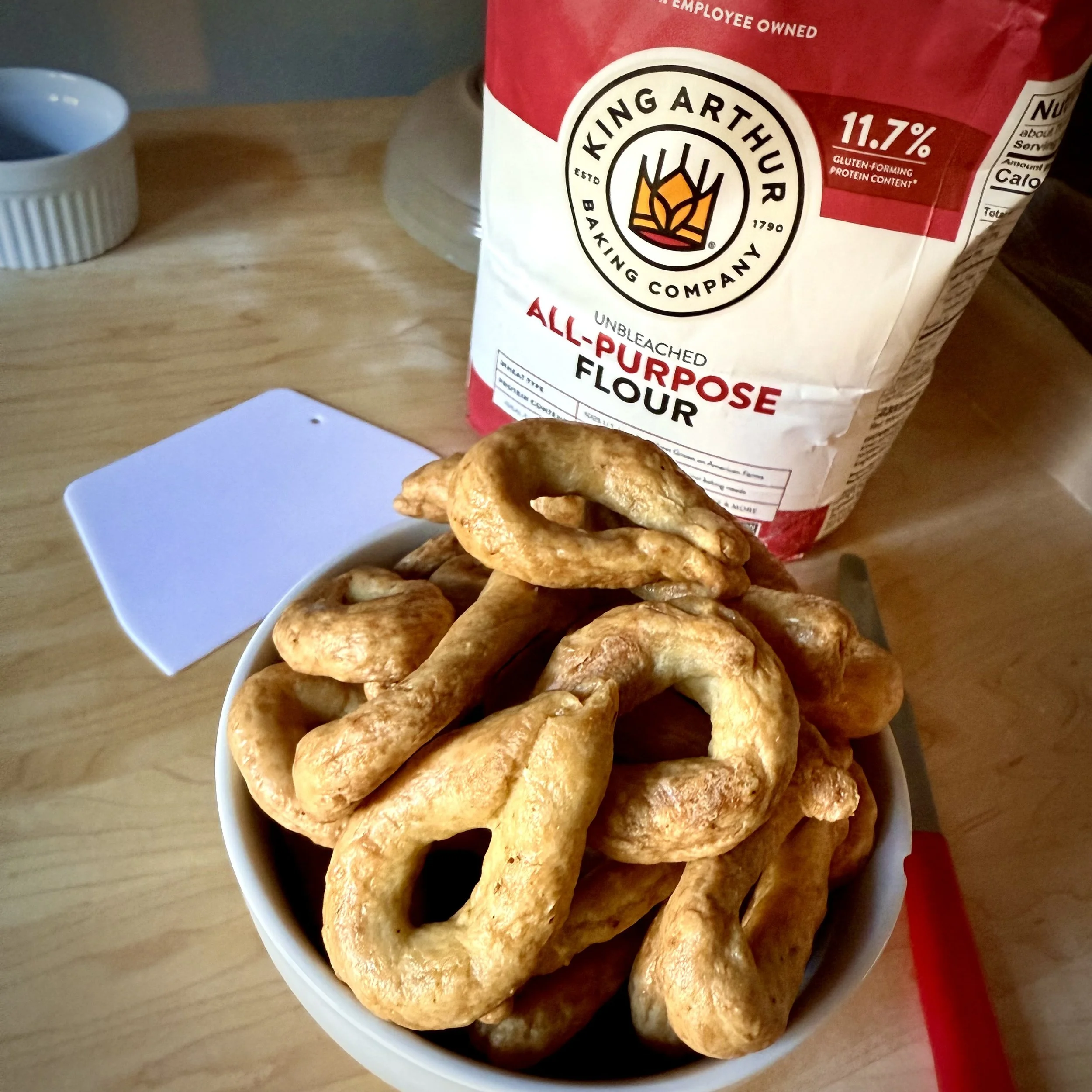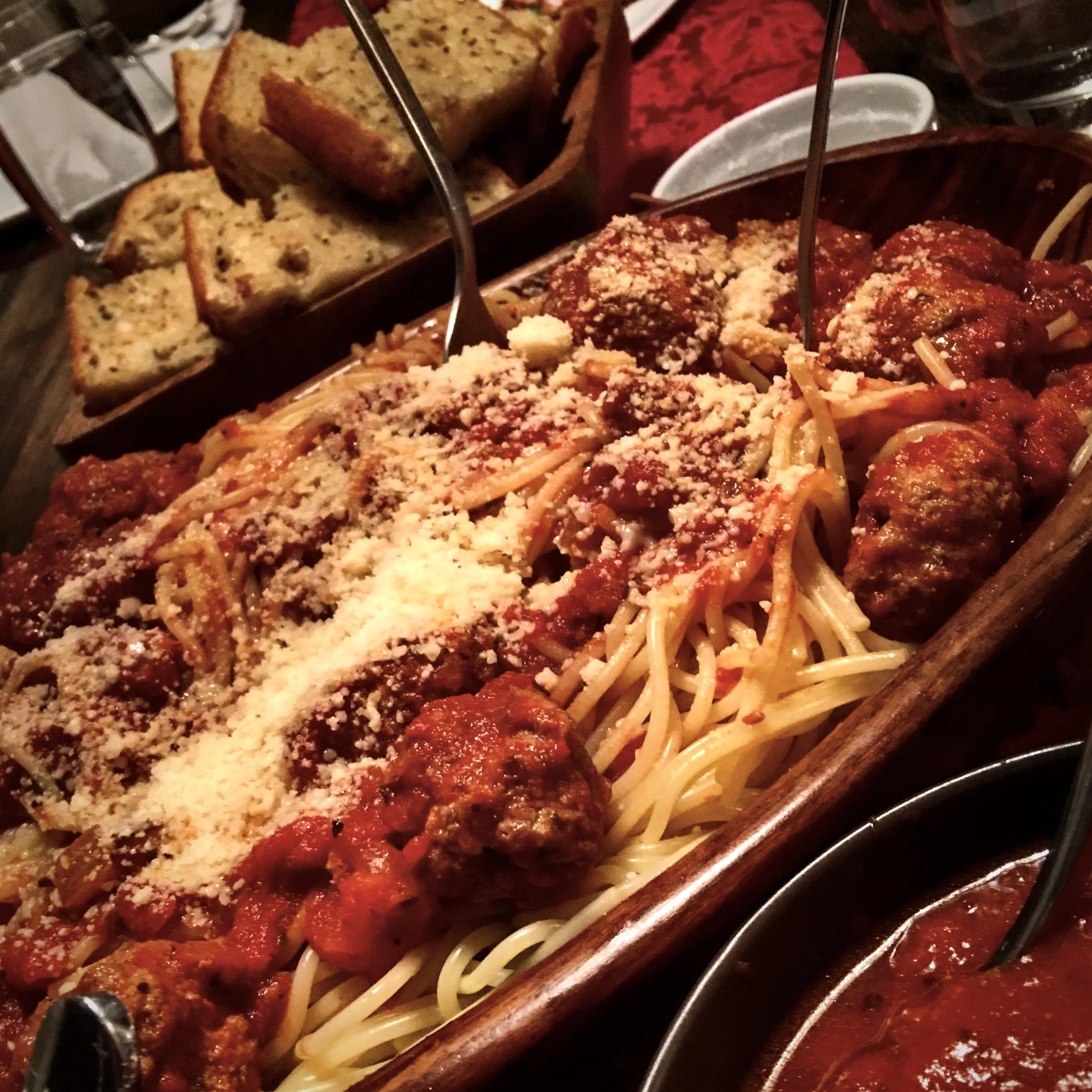Making Our Own Italian Sausage: A Family Tradition
As a third-generation Italian American, Mark has always tried to keep certain traditions alive—or even create new ones—for his own family. One of their favorite things to do together now is make Italian sausage.
Mark grew up in Bristol, Connecticut. Connecticut has the largest percentage of Italians of any state in the U.S., and he was raised in the West End of Bristol, the Italian section of town. There was an Italian bakery, an Italian meat market, and an Italian store with a butcher shop in the back. That little neighborhood shaped who he is and how he cooks today.
Shaping the sausages by hand.
Fridays at the Butcher, Saturdays with Sauce
In Mark’s childhood home, the rhythm of the weekend started on Friday. On his way home from work, Mark’s stepfather would stop at the butcher shop—not for sausage, but for the ground beef, veal, and pork that Mark’s mother used to make her meatballs.
On Saturday morning or early afternoon, his mother would start the sauce for Sunday. She’d mix and roll the meatballs, brown them, and then gently lower them into a big pot of sauce. The flame was always low. The sauce would just barely bubble, slowly percolating away for hours.
Mark will tell you he doesn’t cook his sauce nearly as long as she did. But he still remembers those Saturday afternoons around three or four o’clock, when everyone would sneak into the kitchen and steal a meatball or two to see how they were coming along. They were usually not quite ready—but by Sunday, they’d be perfect.
Sundays at Martino’s
The last thing to go into the sauce was always the sausage.
On Sundays after church, the family would stop at Martino’s to pick up the sausage—usually about three pounds, half sweet and half spicy Italian. While they were there, they’d also grab fresh grated Parmigiano and those fennel-and-pepper “biscuits,” the taralli from Puglia that Mark grew up snacking on.
Taralli, we made a while back. Recipe coming soon….
They would often swing by Luca’s Bakery for a loaf of bread as well. Luca’s later became Mark’s first baking job when he was fifteen, and that experience in the Italian section of their little town is what really started his culinary journey.
Sunday Supper
By the time Sunday rolled around, there was always a massive pot of sauce on the stove, studded with meatballs and sausage. No one ever really knew how many people were coming. It could be four, it could be twelve.
Mark’s mom had a simple solution: “Just throw another box on,” she’d say, because there was always plenty of sauce and plenty of meat. Sometimes most of it disappeared that night, sometimes not. Either way, the next few days were full of meatball subs, sausage with peppers and onions, and plates of leftover meat.
One thing they never had in that house was leftover pasta. Pasta was always cooked fresh.
Those Sunday suppers—crowded table, extra chairs pulled in, bread from Luca’s, sausage from Martino’s—are some of Mark’s favorite memories.
Sunday Suppers’ main event. Spaghetti and meatballs, yes, this is an Italian-American thing.
Why They Make Their Own
As an adult, Mark has always been a quality-focused person. In his professional hospitality career, there was an adage he lived by:
If you can buy better than you can make, you buy.
If you can make better than you can buy, you make.
Growing up, his family bought their sausage from Martino’s. Today, Mark has turned that memory into a hands-on tradition with his own family. With good pork, the right seasoning, and a little time, he believes they can make something at home that’s better than anything he can buy.
So now, they make their own.
One of their favorite ways to use the sausage is in a simple weeknight dish: they take the sausage meat out of the casings, press it between two lemon leaves, and grill it. John’s job is to head outside and pick the biggest lemon leaves he can find, which makes him feel like an essential part of the process. The grilled sausage, perfumed with lemon, is served with a crisp salad and some roasted potatoes—a relaxed, flavorful “any night” supper that all starts with their homemade sausage.
Sausages grilled between lemon leaves.
Mark’s Version of Martino’s Sausage
These days, Mark makes his own version of Sal Martino’s sausage: a mild Italian sausage with fennel. It’s something he does together with his family—a project they tackle side by side in the kitchen.
They’ll make a big batch, then pack it into bags of four links, Cryovac them, and freeze them. That way they can just pull out what they need—whether they’re eating the sausages whole or using the meat in another dish.
One of Mark’s favorite ways to use the sausage is to take it out of the casings, press the meat between lemon leaves, and grill it. A wood grill is ideal, but a gas grill—or even a griddle on the stovetop—works just fine. They’ll serve it with peppers, onions, and roasted potatoes for a quick, rustic supper.
It’s a versatile way to use the sausage and, in a pinch, it makes a fast, satisfying meal for everyone.

Italian Pork Sausage
Ingredients
-
17 Lbs Pork Butt
-
16 oz Red Wine
-
5.4 oz Mild Italian Sausage Seasoning
-
1 pkg Natural Hog Casings
Instructions
- Using a knife, cut the pork into about 2" x 2" pieces of pork.
- Put the meat on a tray and put in the freezer for a few hours to get it really cold and firm it up. It will grind easier.
- Using a 3/8" die grind the meat.
- Season with wine and spices and mix in gently till well incorporated.
- Allow to marinate in the refirgerator over night.
- In a hot pan, cook a small 2 oz portion of the pork mixture. Taste and adjust seasoning.
- Set up your sausage filler and fill casings.
- Once your casing is full twist to make links.
- Portion in to 4 sausages per vaccume bag and freeze.
Notes
• We probably make this size recipe twice a year and keep it in the freezer.
• I like the spice brand that I put the link in the recipe. But feel free to create your own spice blend.
• Some people like to use white wine instead of red wine. Your choice. I'm trying to recreate a childhood memory.
• If you don't get pork butt and use pork shoulder, it has less fat, so buy a pound of pork belly and add that into the grind.
• Link to grinder.
• Link to sausage press.
The Joy Is in the Making
For Mark, a lot of the joy is in the process itself: butchering the meat, grinding it, seasoning it, and trying to get the balance just right. He’s always second-guessing a little—“Is it too salty? Not salty enough? Should I have added more wine? Less?”—because so much depends on the flavor and quality of the pork. It changes from batch to batch.
That’s why he likes to let the seasoned meat marinate overnight. The next day, he’ll fry a little piece, taste it, and adjust the seasoning if needed before stuffing the casings.
On one recent batch, the casings he had on hand had gone bad, so he ran up to their local Italian market in the San Mateo area, Piazza’s. He told the guys, “I’m supposed to make sausage with my kid today, but my casings were bad. Any chance you could sell me a couple so we can still do it?” They were happy to help and loved that making sausage was a father-and-son project.
In the end, that’s what this tradition is really about for Mark: not just the sausage, but the time spent side by side with his own family, passing along a little bit of where he came from.
It’s one of their favorite things to make, and a tradition he’s proud to share.




